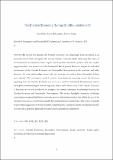The Circular Economy : swings and roundabouts?
Abstract
In the last few decades the Circular Economy has increasingly been advertised as an economic model that can replace the current “linear” economy whilst addressing the issues of environmental deterioration, social equity and long-term economic growth with the explicit suggestion that it can serve as a tool for Sustainable Development. However, despite the individual prominence of the Circular Economy and Sustainable Development in the academic and wider literature, the exact relationship between the two concepts has neither been thoroughly defined nor explored. The consequent result is various inconsistencies occurring across the literature regarding how the Circular Economy can serve as a tool for Sustainable Development and an incomplete understanding of how its long-term effects differ from those of the “linear” economy. A literature review was conducted to interpret the current conceptual relationship between the Circular Economy and Sustainable Development. The review highlights numerous challenges concerning conceptual definition, economic growth and implementation that inhibit the use of the Circular Economy as a tool for Sustainable Development in its current form. The review concludes by providing suggestions for how research concerning the Circular Economy should proceed if it is to provide a potential approach for achieving Sustainable Development.
Citation
Millar , N , McLaughlin , E & Börger , T 2019 , ' The Circular Economy : swings and roundabouts? ' , Ecological Economics , vol. 158 , pp. 11-19 . https://doi.org/10.1016/j.ecolecon.2018.12.012
Publication
Ecological Economics
Status
Peer reviewed
ISSN
0921-8009Type
Journal article
Collections
Items in the St Andrews Research Repository are protected by copyright, with all rights reserved, unless otherwise indicated.

